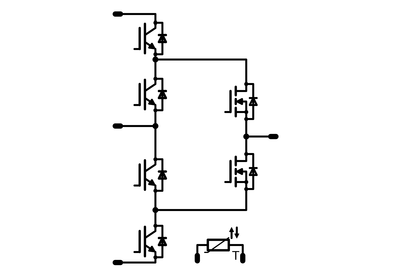ANPC – Active Neutral Point Clamped

Structure
The three-level ANPC topology features six active switches (IGBTs or MOSFETs) and four to six diodes, depending on the switch selection and modulation technique. In most standard applications, the blocking voltage of the components is 950 V or 1200 V, enabling DC-Link voltages beyond 1500 V. All modules are equipped with an NTC alongside the power semiconductors.
Application
Modules with an ANPC topology are used mainly in high efficient three-phase PV inverters and applications with bi-directional operation requirements e.g.: battery storage.
How it works
When an ANPC module is used in inverter operation, the DC-link voltage can be converted into a variable alternating voltage and variable frequency. In contrast to a half-bridge or sixpack, an ANPC topology offers an additional voltage level at the output. The potential cannot only move between DC+ and DC-; it can also have a status of 0. There are two main modulation techniques used for ANPC topology. In the first one, the four switches connected to the DC-Link are switched at line frequency (50-60 Hz), while the other two switch with the desired choke frequency, usually above 16 kHz. The second commonly used technique is exactly the opposite, the four switches connected to the DC-link commute at the choke frequency while the other two will switch at line frequency.
It is to be noted that semiconductors with a higher blocking voltage capability switch slower than semiconductors with lower blocking voltage capability. NPC topologies with 650 V components can therefore be operated at higher switching frequencies than 1200 V half-bridges. Furthermore, double the frequency is applied to the output filter.
The MNPC and NPC topologies are an alternative to the ANPC module. They also work with three levels at the output. Each topology has its advantages, depending on the switching frequency, DC-Link voltage, power ranges and conversion mode.
The special benefit of the ANPC topology is the possibility to distinguish the fast and slow switching components in all four possible operation quadrants, this offers the advantage of bi-directional operation without compromise in efficiency.
To learn more and see the full range of products, follow this link: Three-level ANPC

